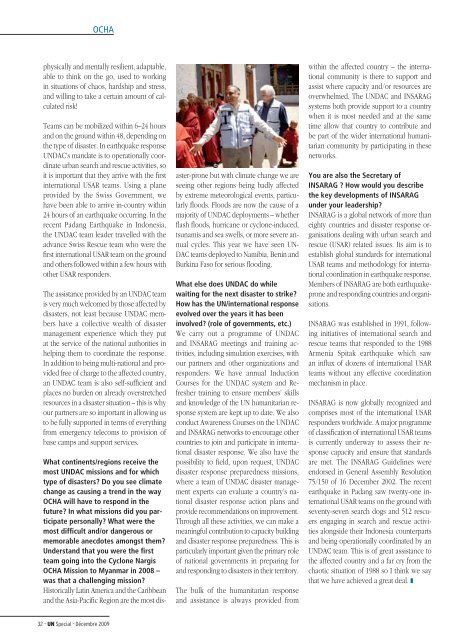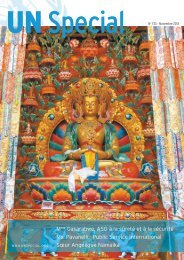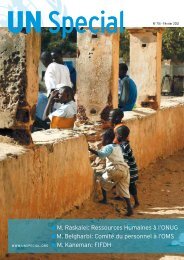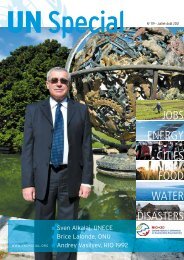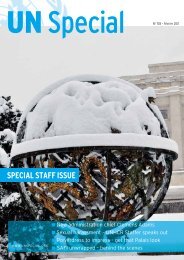PDF version - UN Special
PDF version - UN Special
PDF version - UN Special
- No tags were found...
Create successful ePaper yourself
Turn your PDF publications into a flip-book with our unique Google optimized e-Paper software.
OCHAphysically and mentally resilient, adaptable,able to think on the go, used to workingin situations of chaos, hardship and stress,and willing to take a certain amount of calculatedrisk!Teams can be mobilized within 6–24 hoursand on the ground within 48, depending onthe type of disaster. In earthquake response<strong>UN</strong>DAC’s mandate is to operationally coordinateurban search and rescue activities, soit is important that they arrive with the firstinternational USAR teams. Using a planeprovided by the Swiss Government, wehave been able to arrive in-country within24 hours of an earthquake occurring. In therecent Padang Earthquake in Indonesia,the <strong>UN</strong>DAC team leader travelled with theadvance Swiss Rescue team who were thefirst international USAR team on the groundand others followed within a few hours withother USAR responders.The assistance provided by an <strong>UN</strong>DAC teamis very much welcomed by those affected bydisasters, not least because <strong>UN</strong>DAC membershave a collective wealth of disastermanagement experience which they putat the service of the national authorities inhelping them to coordinate the response.In addition to being multi-national and providedfree of charge to the affected country,an <strong>UN</strong>DAC team is also self-sufficient andplaces no burden on already overstretchedresources in a disaster situation – this is whyour partners are so important in allowing usto be fully supported in terms of everythingfrom emergency telecoms to provision ofbase camps and support services.What continents/regions receive themost <strong>UN</strong>DAC missions and for whichtype of disasters? Do you see climatechange as causing a trend in the wayOCHA will have to respond in thefuture? In what missions did you participatepersonally? What were themost difficult and/or dangerous ormemorable anecdotes amongst them?Understand that you were the firstteam going into the Cyclone NargisOCHA Mission to Myanmar in 2008 –was that a challenging mission?Historically Latin America and the Caribbeanand the Asia-Pacific Region are the most disaster-pronebut with climate change we areseeing other regions being badly affectedby extreme meteorological events, particularlyfloods. Floods are now the cause of amajority of <strong>UN</strong>DAC deployments – whetherflash floods, hurricane or cyclone-induced,tsunamis and sea swells, or more severe annualcycles. This year we have seen <strong>UN</strong>-DAC teams deployed to Namibia, Benin andBurkina Faso for serious flooding.What else does <strong>UN</strong>DAC do whilewaiting for the next disaster to strike?How has the <strong>UN</strong>/international responseevolved over the years it has beeninvolved? (role of governments, etc.)We carry out a programme of <strong>UN</strong>DACand INSARAG meetings and training activities,including simulation exercises, withour partners and other organizations andresponders. We have annual InductionCourses for the <strong>UN</strong>DAC system and Refreshertraining to ensure members’ skillsand knowledge of the <strong>UN</strong> humanitarian responsesystem are kept up to date. We alsoconduct Awareness Courses on the <strong>UN</strong>DACand INSARAG networks to encourage othercountries to join and participate in internationaldisaster response. We also have thepossibility to field, upon request, <strong>UN</strong>DACdisaster response preparedness missions,where a team of <strong>UN</strong>DAC disaster managementexperts can evaluate a country’s nationaldisaster response action plans andprovide recommendations on improvement.Through all these activities, we can make ameaningful contribution to capacity buildingand disaster response preparedness. This isparticularly important given the primary roleof national governments in preparing forand responding to disasters in their territory.The bulk of the humanitarian responseand assistance is always provided fromwithin the affected country – the internationalcommunity is there to support andassist where capacity and/or resources areoverwhelmed. The <strong>UN</strong>DAC and INSARAGsystems both provide support to a countrywhen it is most needed and at the sametime allow that country to contribute andbe part of the wider international humanitariancommunity by participating in thesenetworks.You are also the Secretary ofINSARAG ? How would you describethe key developments of INSARAGunder your leadership?INSARAG is a global network of more thaneighty countries and disaster response organisationsdealing with urban search andrescue (USAR) related issues. Its aim is toestablish global standards for internationalUSAR teams and methodology for internationalcoordination in earthquake response.Members of INSARAG are both earthquakeproneand responding countries and organisations.INSARAG was established in 1991, followinginitiatives of international search andrescue teams that responded to the 1988Armenia Spitak earthquake which sawan influx of dozens of international USARteams without any effective coordinationmechanism in place.INSARAG is now globally recognized andcomprises most of the international USARresponders worldwide. A major programmeof classification of international USAR teamsis currently underway to assess their responsecapacity and ensure that standardsare met. The INSARAG Guidelines wereendorsed in General Assembly Resolution75/150 of 16 December 2002. The recentearthquake in Padang saw twenty-one internationalUSAR teams on the ground withseventy-seven search dogs and 512 rescuersengaging in search and rescue activitiesalongside their Indonesia counterpartsand being operationally coordinated by an<strong>UN</strong>DAC team. This is of great assistance tothe affected country and a far cry from thechaotic situation of 1988 so I think we saythat we have achieved a great deal. ❚32 – <strong>UN</strong> <strong>Special</strong> – Décembre 2009


